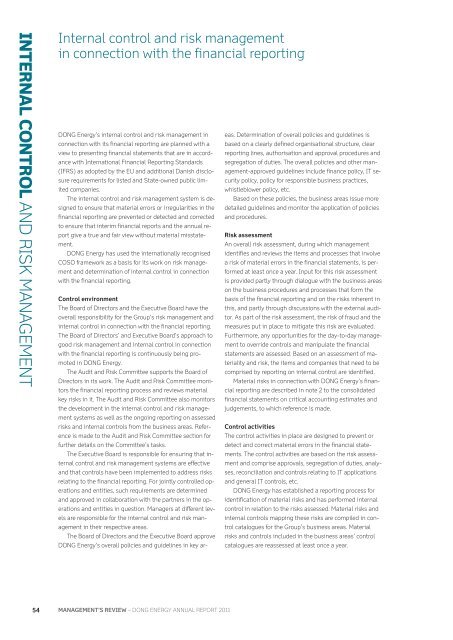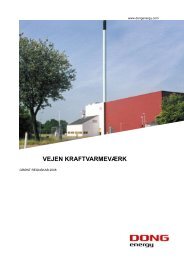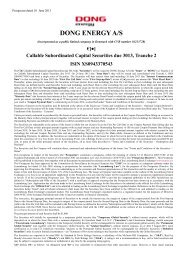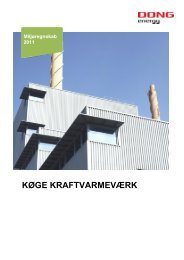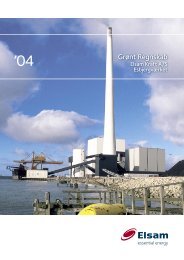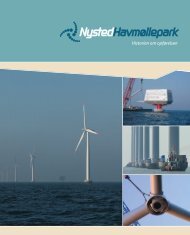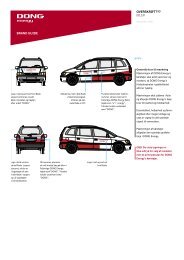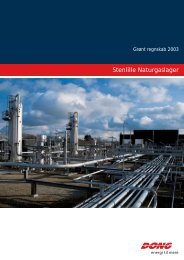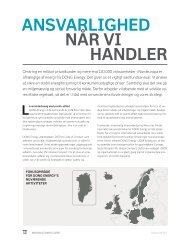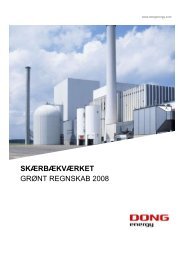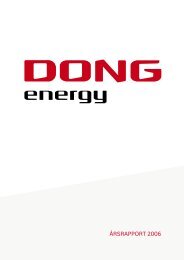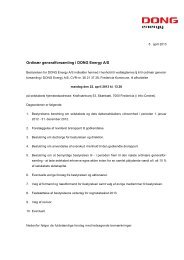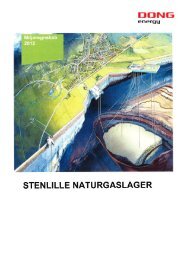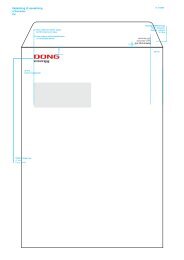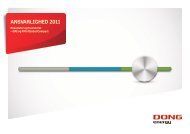ANNUAL REPORT 2011 - DONG Energy
ANNUAL REPORT 2011 - DONG Energy
ANNUAL REPORT 2011 - DONG Energy
Create successful ePaper yourself
Turn your PDF publications into a flip-book with our unique Google optimized e-Paper software.
InteRnal contRol AND RISK MANAGEMENT<br />
54<br />
Internal control and risk management<br />
in connection with the financial reporting<br />
<strong>DONG</strong> <strong>Energy</strong>’s internal control and risk management in<br />
connection with its financial reporting are planned with a<br />
view to presenting financial statements that are in accordance<br />
with International Financial Reporting Standards<br />
(IFRS) as adopted by the EU and additional Danish disclosure<br />
requirements for listed and State-owned public limited<br />
companies.<br />
The internal control and risk management system is designed<br />
to ensure that material errors or irregularities in the<br />
financial reporting are prevented or detected and corrected<br />
to ensure that interim financial reports and the annual report<br />
give a true and fair view without material misstatement.<br />
<strong>DONG</strong> <strong>Energy</strong> has used the internationally recognised<br />
COSO framework as a basis for its work on risk management<br />
and determination of internal control in connection<br />
with the financial reporting.<br />
Control environment<br />
The Board of Directors and the Executive Board have the<br />
overall responsibility for the Group’s risk management and<br />
internal control in connection with the financial reporting.<br />
The Board of Directors’ and Executive Board’s approach to<br />
good risk management and internal control in connection<br />
with the financial reporting is continuously being promoted<br />
in <strong>DONG</strong> <strong>Energy</strong>.<br />
The Audit and Risk Committee supports the Board of<br />
Directors in its work. The Audit and Risk Committee monitors<br />
the financial reporting process and reviews material<br />
key risks in it. The Audit and Risk Committee also monitors<br />
the development in the internal control and risk management<br />
systems as well as the ongoing reporting on assessed<br />
risks and internal controls from the business areas. Reference<br />
is made to the Audit and Risk Committee section for<br />
further details on the Committee’s tasks.<br />
The Executive Board is responsible for ensuring that internal<br />
control and risk management systems are effective<br />
and that controls have been implemented to address risks<br />
relating to the financial reporting. For jointly controlled operations<br />
and entities, such requirements are determined<br />
and approved in collaboration with the partners in the operations<br />
and entities in question. Managers at different levels<br />
are responsible for the internal control and risk management<br />
in their respective areas.<br />
The Board of Directors and the Executive Board approve<br />
<strong>DONG</strong> <strong>Energy</strong>’s overall policies and guidelines in key ar-<br />
manaGEmEnt’s rEviEw – <strong>DONG</strong> ENERGY <strong>ANNUAL</strong> <strong>REPORT</strong> <strong>2011</strong><br />
eas. Determination of overall policies and guidelines is<br />
based on a clearly defined organisational structure, clear<br />
reporting lines, authorisation and approval procedures and<br />
segregation of duties. The overall policies and other management-approved<br />
guidelines include finance policy, IT security<br />
policy, policy for responsible business practices,<br />
whistleblower policy, etc.<br />
Based on these policies, the business areas issue more<br />
detailed guidelines and monitor the application of policies<br />
and procedures.<br />
risk assessment<br />
An overall risk assessment, during which management<br />
identifies and reviews the items and processes that involve<br />
a risk of material errors in the financial statements, is performed<br />
at least once a year. Input for this risk assessment<br />
is provided partly through dialogue with the business areas<br />
on the business procedures and processes that form the<br />
basis of the financial reporting and on the risks inherent in<br />
this, and partly through discussions with the external auditor.<br />
As part of the risk assessment, the risk of fraud and the<br />
measures put in place to mitigate this risk are evaluated.<br />
Furthermore, any opportunities for the day-to-day management<br />
to override controls and manipulate the financial<br />
statements are assessed. Based on an assessment of materiality<br />
and risk, the items and companies that need to be<br />
comprised by reporting on internal control are identified.<br />
Material risks in connection with <strong>DONG</strong> <strong>Energy</strong>’s financial<br />
reporting are described in note 2 to the consolidated<br />
financial statements on critical accounting estimates and<br />
judgements, to which reference is made.<br />
Control activities<br />
The control activities in place are designed to prevent or<br />
detect and correct material errors in the financial statements.<br />
The control activities are based on the risk assessment<br />
and comprise approvals, segregation of duties, analyses,<br />
reconciliation and controls relating to IT applications<br />
and general IT controls, etc.<br />
<strong>DONG</strong> <strong>Energy</strong> has established a reporting process for<br />
identification of material risks and has performed internal<br />
control in relation to the risks assessed. Material risks and<br />
internal controls mapping these risks are compiled in control<br />
catalogues for the Group’s business areas. Material<br />
risks and controls included in the business areas’ control<br />
catalogues are reassessed at least once a year.


